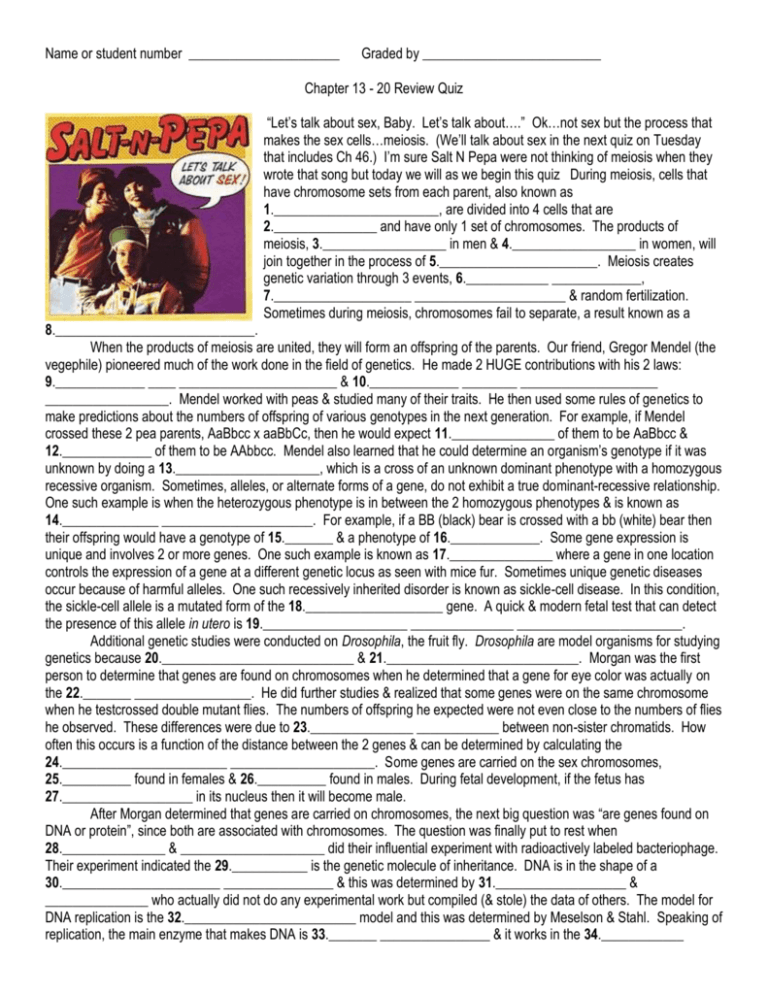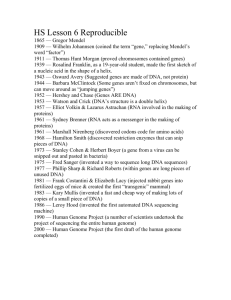Chapters 13-20 "Fill in the Blank"
advertisement

Name or student number ______________________ Graded by __________________________ Chapter 13 - 20 Review Quiz “Let’s talk about sex, Baby. Let’s talk about….” Ok…not sex but the process that makes the sex cells…meiosis. (We’ll talk about sex in the next quiz on Tuesday that includes Ch 46.) I’m sure Salt N Pepa were not thinking of meiosis when they wrote that song but today we will as we begin this quiz During meiosis, cells that have chromosome sets from each parent, also known as 1.________________________, are divided into 4 cells that are 2._______________ and have only 1 set of chromosomes. The products of meiosis, 3.__________________ in men & 4.__________________ in women, will join together in the process of 5._______________________. Meiosis creates genetic variation through 3 events, 6.____________ _____________, 7.____________________ ______________________ & random fertilization. Sometimes during meiosis, chromosomes fail to separate, a result known as a 8._____________________________. When the products of meiosis are united, they will form an offspring of the parents. Our friend, Gregor Mendel (the vegephile) pioneered much of the work done in the field of genetics. He made 2 HUGE contributions with his 2 laws: 9._____________ ____ _______________________ & 10._____________ ________ ____________________ __________________. Mendel worked with peas & studied many of their traits. He then used some rules of genetics to make predictions about the numbers of offspring of various genotypes in the next generation. For example, if Mendel crossed these 2 pea parents, AaBbcc x aaBbCc, then he would expect 11._______________ of them to be AaBbcc & 12._____________ of them to be AAbbcc. Mendel also learned that he could determine an organism’s genotype if it was unknown by doing a 13._____________________, which is a cross of an unknown dominant phenotype with a homozygous recessive organism. Sometimes, alleles, or alternate forms of a gene, do not exhibit a true dominant-recessive relationship. One such example is when the heterozygous phenotype is in between the 2 homozygous phenotypes & is known as 14.______________ ______________________. For example, if a BB (black) bear is crossed with a bb (white) bear then their offspring would have a genotype of 15._______ & a phenotype of 16._____________. Some gene expression is unique and involves 2 or more genes. One such example is known as 17._______________ where a gene in one location controls the expression of a gene at a different genetic locus as seen with mice fur. Sometimes unique genetic diseases occur because of harmful alleles. One such recessively inherited disorder is known as sickle-cell disease. In this condition, the sickle-cell allele is a mutated form of the 18.____________________ gene. A quick & modern fetal test that can detect the presence of this allele in utero is 19._____________________ _______________ ________________________. Additional genetic studies were conducted on Drosophila, the fruit fly. Drosophila are model organisms for studying genetics because 20.____________________________ & 21.____________________________. Morgan was the first person to determine that genes are found on chromosomes when he determined that a gene for eye color was actually on the 22._______ _________________. He did further studies & realized that some genes were on the same chromosome when he testcrossed double mutant flies. The numbers of offspring he expected were not even close to the numbers of flies he observed. These differences were due to 23._______________ ____________ between non-sister chromatids. How often this occurs is a function of the distance between the 2 genes & can be determined by calculating the 24.________________________ _____________________. Some genes are carried on the sex chromosomes, 25.__________ found in females & 26.__________ found in males. During fetal development, if the fetus has 27.___________________ in its nucleus then it will become male. After Morgan determined that genes are carried on chromosomes, the next big question was “are genes found on DNA or protein”, since both are associated with chromosomes. The question was finally put to rest when 28._______________ & _____________________ did their influential experiment with radioactively labeled bacteriophage. Their experiment indicated the 29.___________ is the genetic molecule of inheritance. DNA is in the shape of a 30._______________________ ________________ & this was determined by 31.___________________ & _______________ who actually did not do any experimental work but compiled (& stole) the data of others. The model for DNA replication is the 32._________________________ model and this was determined by Meselson & Stahl. Speaking of replication, the main enzyme that makes DNA is 33._______ ________________ & it works in the 34.____________ direction as it makes DNA. After DNA has been made, the enzyme 35._______ ______________________ will create a phosphodiester bond to join the individual fragments together. One theory of aging relates to adult chromosomes shortening because they do not have the functional enzyme 36._______________________ to maintain the integrity of the telomeres. Now let’s move on to transcription & translation & how they are regulated. Translation is the conversion of 37._______ ____ _____________ while transcription is the conversion of 38._____________ _____ ________________. Transcription takes place in the 39._______________ when transcription factors bind to the 40._________ __________ of the promoter. Farther upstream, other transcription factors known as 41._____________________ will also bind to the DNA to allow for tissue specific transcription. Once the transcription factors have bound to the DNA, transcription can begin as the enzyme 42.______ _______________________ makes RNA in the 43.__________________ direction. Energy for this anabolic reaction of incorporating each nucleotide comes from the respective 44._______________. After transcription, the RNA is processed on the ends as a poly-A tail is added to the 45.____ ___________ and a guanine cap is added to the 46._______ ___________. In the middle of the transcript, the processing continues as the 47.____________ are removed and the 48._____________ are spliced together. Now that the RNA is completely processed, it is exported to the cytosol for translation to occur. Here the RNA is “read” on the ribosome in groups of 3 known as a 49._______. This reading takes place as 50.____________ with its anticodon complementarily binds to correct sequence & transfers its 51.__________ ______________ to the growing polypeptide chain. The polypeptide chain will then adopt its proper 3D shape and carry out its function until it becomes damaged or is not longer needed. At this point, a molecule of 52.__________________ will be added to target the polypeptide for degradation by a proteosome. Similarly, the mRNA will de degraded through the combined actions of 53._______________ and the enzyme dicer. Now let’s move on to viruses & bacteria. Viruses have 2 general reproductive cycles, the 54._________________ cycle in which virulent viruses immediately kill the host cell, & the 55.________________________ cycle in which temparate virus can “hide” within the host’s genome. Some viruses, like HIV, have an RNA genome and they are known as 56._______________________. These types of viruses have the enzyme 57.___________________ _______________ that converts their RNA back to DNA. Viruses infect specific cells because they have proteins on their exteriors that are complementary to a 58._________________________ on the host cell. DNA replication in bacteria can occur much quicker than in eukaryotes because their DNA polymerase lacks the ability to 59._____________________________ and thereby makes lots of mistakes in copying the DNA. Something else unique about bacteria is how they can coordinately regulate a cluster of genes involved in a specific pathway. This cluster of genes is known as an operon. The trp operon is turned off when 60.________________________ is in excess whereas the lac operon is turned off when 61.______________ _____ _________________________. When we covered biotechnology, we discussed many different techniques & even performed some in our labs. One such technique was transformation. By definition, transformation is 62.____________________________________ _______________________________________________________________________________________________. We did this by heat-shocking bacteria. We then did the CSI investigation to determine who the actual attacker was in our crime. Since there was so little biological DNA evidence left at the crime scene, we needed to make more by performing 63._________________ to amplify the DNA. We then took these amplified products and separated them by length in the process of 64.____________ ________________________________. The DNA was able to migrate down the apparatus because it has a 65..____________________________ charge. If we were doing research and wanted to see the effects of a new drug on many genes within our model of interest, we would use a 66.____________ ________________________ to look at many genes at once. The primary method of DNA sequencing uses 67.__________________________________ to terminate DNA strands as they are being made.







